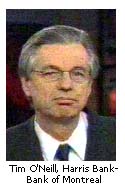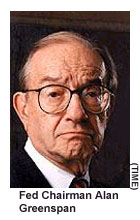|
Fed lifts key rates again
|
 |
March 21, 2000: 3:10 p.m. ET
Fed funds rate, discount rate raised a quarter point each to slow growth
By Staff Writer M. Corey Goldman
|
NEW YORK (CNNfn) - The Federal Reserve Tuesday lifted short-term interest rates by another quarter point -- the fifth increase in less than eight months -- in an effort to slow the seemingly unstoppable U.S. economy and ensure prices for goods and services remain in check.
It also put another warning shot over Wall Street's bow that it likely will raise rates again in the face of what it sees as a risk for an outbreak of inflation.
 As expected, the Fed's policy-making arm raised its influential Fed funds target for overnight loans between banks to 6 percent, the highest since mid-1995 -- a point where the Fed decided to lift the release brake following a series of aggressive rate increases that generated what many on Wall Street call a "soft landing." It also raised its less tinkered with discount rate -- the rate at which the Fed's 12 district banks lend directly to financial institutions -- to 5.5 percent, the highest for that rate since August 31, 1991. As expected, the Fed's policy-making arm raised its influential Fed funds target for overnight loans between banks to 6 percent, the highest since mid-1995 -- a point where the Fed decided to lift the release brake following a series of aggressive rate increases that generated what many on Wall Street call a "soft landing." It also raised its less tinkered with discount rate -- the rate at which the Fed's 12 district banks lend directly to financial institutions -- to 5.5 percent, the highest for that rate since August 31, 1991.
For consumers, the rate increase means interest payments on their credit cards and lines of credit are once again going up. The Fed hopes such increases will make consumers think twice about charging that expensive meal or buying that new notebook computer. The same goes for companies, which will be paying a little more to borrow money to finance their ventures.
Indeed, some of the country's major financial institutions immediately announced a quarter-point increase in their prime lending rate -- the rate they charge their best customers to borrow money. Bank of America (BAC: Research, Estimates) led the pack, lifting its prime rate to 9 percent from 8.75 percent effective Wednesday.
Non-event for Wall St.
For financial markets, the rate increase and the short announcement that followed was a non-event, mostly because Wall Street had widely expected the Fed to do exactly what it did. Stocks turned in a positive performance in the wake of the announcement, while bonds held on to gains already made before the Fed's statement crossed computer screens mid-afternoon.
In the usual, briefly worded statement the central bank releases with its rate changes, the Federal Open Market Committee said that it "remains concerned that increases in demand will continue to exceed the growth potential supply, which could foster inflationary imbalances that would undermine the economy's record economic expansion."
 What has confused Main Street is why the Fed continues to raise rates at a time when the economy is in its heyday of growth, and when inflation, with the exception of rising oil prices, remains almost a complete no-show. What has confused Main Street is why the Fed continues to raise rates at a time when the economy is in its heyday of growth, and when inflation, with the exception of rising oil prices, remains almost a complete no-show.
Indeed, with the exception of commodities such as oil and natural gas, prices for items like computers, wireless phones, DVD players and other goods have actually declined. Higher productivity and fierce competition have kept retailers from raising prices while still improving profit margins -- a mix that Wall Street certainly likes.
But a growing contingent on Wall Street is beginning to publicly question why the Fed is not acting more aggressively -- particularly with the economy expanding at a near 7-percent pace, with wage pressures beginning to build, with oil prices near all-time highs, with prices for some goods and services beginning to rise and with the country's trade deficit at a record.
More on the way
"As far as we can tell, just about everyone now expects another 25-basis-point hike on May 16, which rather begs the question why the Fed did not act more boldly today and raise rates by 50 basis points," said Ian Shepherdson, chief U.S. economist with High Frequency Economics. "By the time of the May meeting, a bigger move might be forced upon the FOMC."
 Indeed, financial markets are already pricing in another quarter-point move at the FOMC's May 16th meeting and yet another one at the June 26-28 meeting. The yield on fed funds futures contract, which indicates where investors are betting the fed funds rate will be down the road, now rests at 6.27 percent; the yield on the June contract stands at 6.36 percent. Indeed, financial markets are already pricing in another quarter-point move at the FOMC's May 16th meeting and yet another one at the June 26-28 meeting. The yield on fed funds futures contract, which indicates where investors are betting the fed funds rate will be down the road, now rests at 6.27 percent; the yield on the June contract stands at 6.36 percent.
"This is a train that's really moving down the track and a couple of logs are not going to stop it," Tim O'Neill, chief economist with Harris Bank-Bank of Montreal, told CNNfn. He's expecting even more moves than the markets are pricing in -- an additional 1 percent increase in rates before year's end. (550KB WAV) (550KB AIFF)
Greenspan's main concern, according to a speech he gave earlier this month, is that the economy, already straining from the effects of higher oil prices, can't keep up with the demand that exuberant demand consumers continue to show -- something that will lead to inflation if left unchecked.
Productivity: good and bad
Even so, inflation remains remarkably tame. Consumer prices outside of food and energy increased just 1.9 percent in 1999, the slowest in 34 years. Year-over-year, the core CPI rose 2.1 percent in February, suggesting that a near tripling of oil prices in the past year isn't yet filtering its way into the prices of goods and services.
Part of the reason inflation has remained so low is because of worker productivity -- where technology, automation, and other high-tech factors have made workers more efficient, thus allowing companies to keep their costs in check by squeezing more output from their employees. Productivity increased at a 6.4 percent annual rate in the fourth quarter -- the fastest pace in seven years.
 Greenspan has lately said that even productivity gains may have a downside. With productivity gains come heightened expectations for corporate earnings, and that pushes up stock prices, he said. Higher stock prices lead to greater wealth, and consumer spending, pushing the economy to its limits, he said. Greenspan has lately said that even productivity gains may have a downside. With productivity gains come heightened expectations for corporate earnings, and that pushes up stock prices, he said. Higher stock prices lead to greater wealth, and consumer spending, pushing the economy to its limits, he said.
"The pickup in productivity tends to create even greater increases in aggregate demand than in potential aggregate supply," Greenspan said.
Most actually agree with Greenspan's assessment, and expect it will take more rate increases to slow the economy down to a more sustainable 3-percent or 3.5-percent pace -- a level that would ensure the economy continues along its merry path of record expansion without igniting inflation.
And for the market?
"Where few seem to be in agreement is exactly how many more rate increases that will be," said Rob Palombi, a markets analyst with Standard & Poor's MMS. "Much of it will depend on how the economy responds to the Fed's recent moves, but it seems clear more action will need to be taken."
 As for the stock market, Palombi doesn't expect the rate increases will have much of an impact on corporate profits. Part of the reason is because demand both at home and overseas for American goods will remain strong. For another, cheap imports spurred by a strong U.S. dollar will keep U.S. companies from raising prices and getting undercut by overseas competitors. As for the stock market, Palombi doesn't expect the rate increases will have much of an impact on corporate profits. Part of the reason is because demand both at home and overseas for American goods will remain strong. For another, cheap imports spurred by a strong U.S. dollar will keep U.S. companies from raising prices and getting undercut by overseas competitors.
What's more, yields on both government and corporate bonds and notes are still at a level where companies can afford to borrow without paying exorbitant rates of interest -- something that will ensure capital continues to flow and returns continue to be generated.
"Higher rates will eventually reign in the market, but it will likely take additional moves for that to happen in a discernible way," Palombi said. "Whether those moves actually come is something the market can put out of its thinking -- at least until May." 
|
|
|
|
|
|
U.S. Federal Reserve
|
Note: Pages will open in a new browser window
External sites are not endorsed by CNNmoney
|
|
|
|
 |

|

